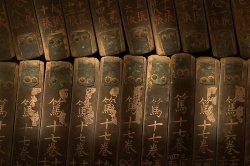Difference between revisions of "Dragon king's daughter"
| (One intermediate revision by the same user not shown) | |||
| Line 1: | Line 1: | ||
[[File:Tripiṭak75,f.jpg|thumb|250px|]] | [[File:Tripiṭak75,f.jpg|thumb|250px|]] | ||
| + | |||
| + | |||
| + | |||
| + | |||
| + | |||
| + | |||
<poem> | <poem> | ||
[[dragon king's daughter]] | [[dragon king's daughter]] | ||
| + | |||
| + | |||
[[竜女]] ( Jpn [[ryunyo]] ) | [[竜女]] ( Jpn [[ryunyo]] ) | ||
| − | |||
| − | |||
| − | Second, it reveals that the [[power]] of the [[Lotus Sutra]] enables all [[people]] equally to attain [[Buddhahood]] in their {{Wiki|present}} [[form]], without undergoing [[kalpas]] of austere practices. Perhaps the {{Wiki|social}} circumstances in which the [[Lotus Sutra]] was compiled did not allow the [[dragon]] | + | Also, [[dragon girl]] or [[naga girl]]. The eight-year-old [[daughter of Sagara]], one of the eight great [[dragon]] {{Wiki|kings}} said to dwell in a palace at the bottom of the sea. According to the "[[Devadatta]]" (twelfth) [[chapter]] of the [[Lotus Sutra]], the [[dragon girl]] [[conceived]] the [[desire]] for [[enlightenment]] when she [[heard]] [[Bodhisattva]] [[Manjushri]] {{Wiki|preach}} the [[Lotus Sutra]] in the [[dragon king's]] palace. When [[Manjushri]] asserts that she is capable of quickly [[attaining]] the [[Buddha wisdom]], [[Bodhisattva]] [[Wisdom Accumulated]] challenges him, saying that even [[Shakyamuni]] [[attained]] [[enlightenment]] only after fulfilling the [[bodhisattva]] practice for many [[kalpas]], and that she cannot become a [[Buddha]] so easily. Just then the [[dragon]] girl appears in front of the assembly and praises [[Shakyamuni Buddha]]. [[Shariputra]] then speaks to her, saying that women are [[subject]] to the [[five obstacles]] and are incapable of [[attaining]] [[Buddhahood]]. |
| + | |||
| + | At that [[moment]], she offers a [[jewel]] to the [[Buddha]], transforms herself into a {{Wiki|male}}, and instantaneously perfects the [[bodhisattva]] practice. She then appears in a land to the {{Wiki|south}} called [[Spotless World]] and [[manifests]] the [[state]] of [[Buddhahood]] without changing her [[dragon]] [[form]]. With the [[thirty-two features}} and [[eighty characteristics]] of a [[Buddha]], she preaches the [[Lotus Sutra]] to all [[living beings]] there.The [[dragon girl's]] [[enlightenment]] has important implications. First, it refutes the [[idea]] of the [[time]] that women could never attain [[enlightenment]]. | ||
| + | |||
| + | Second, it reveals that the [[power]] of the [[Lotus Sutra]] enables all [[people]] equally to attain [[Buddhahood]] in their {{Wiki|present}} [[form]], without undergoing [[kalpas]] of [[austere]] practices. Perhaps the {{Wiki|social}} circumstances in which the [[Lotus Sutra]] was compiled did not allow the [[dragon girl]] to be depicted as [[attaining]] [[Buddhahood]] without first becoming a {{Wiki|male}}. But the [[transformation]] occurred instantaneously, not in the next [[life]], and in this [[respect]] differs significantly from that of other, [[provisional teachings]], which hold that a woman must be [[reborn]] as a man and then practice [[bodhisattva]] austerities for {{Wiki|innumerable}} [[kalpas]] in [[order]] to become a [[Buddha]]. | ||
See also [[dragon]] [[deity]]. | See also [[dragon]] [[deity]]. | ||
| + | |||
| + | |||
</poem> | </poem> | ||
{{R}} | {{R}} | ||
Latest revision as of 18:35, 6 January 2024
dragon king's daughter
竜女 ( Jpn ryunyo )
Also, dragon girl or naga girl. The eight-year-old daughter of Sagara, one of the eight great dragon kings said to dwell in a palace at the bottom of the sea. According to the "Devadatta" (twelfth) chapter of the Lotus Sutra, the dragon girl conceived the desire for enlightenment when she heard Bodhisattva Manjushri preach the Lotus Sutra in the dragon king's palace. When Manjushri asserts that she is capable of quickly attaining the Buddha wisdom, Bodhisattva Wisdom Accumulated challenges him, saying that even Shakyamuni attained enlightenment only after fulfilling the bodhisattva practice for many kalpas, and that she cannot become a Buddha so easily. Just then the dragon girl appears in front of the assembly and praises Shakyamuni Buddha. Shariputra then speaks to her, saying that women are subject to the five obstacles and are incapable of attaining Buddhahood.
At that moment, she offers a jewel to the Buddha, transforms herself into a male, and instantaneously perfects the bodhisattva practice. She then appears in a land to the south called Spotless World and manifests the state of Buddhahood without changing her dragon form. With the [[thirty-two features}} and eighty characteristics of a Buddha, she preaches the Lotus Sutra to all living beings there.The dragon girl's enlightenment has important implications. First, it refutes the idea of the time that women could never attain enlightenment.
Second, it reveals that the power of the Lotus Sutra enables all people equally to attain Buddhahood in their present form, without undergoing kalpas of austere practices. Perhaps the social circumstances in which the Lotus Sutra was compiled did not allow the dragon girl to be depicted as attaining Buddhahood without first becoming a male. But the transformation occurred instantaneously, not in the next life, and in this respect differs significantly from that of other, provisional teachings, which hold that a woman must be reborn as a man and then practice bodhisattva austerities for innumerable kalpas in order to become a Buddha.
See also dragon deity.
